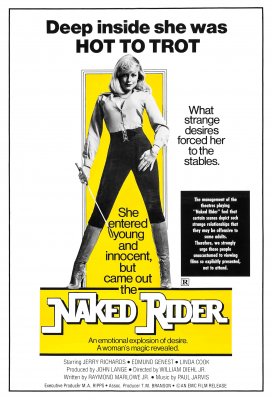
This is a pretty good little B-movie typical of regional films marketed primarily to southern drive-in’s back in the early 70s.
Our story involves rancher “Big Jim.” He pretty much owns the whole county–the land, the banks, the newspapers, the politicians. We don’t know much about how Big Jim got to be so rich and powerful, but we do learn his biggest interest in life seems to be harness racing and an elusive desire to breed a winning racehorse.
Big Jim also has a taste for extramarital affairs, but of course his swinging lifestyle isn’t something he chooses to share with his “proper” wife, Melody, who is forbidden to leave the house.
When Melody complains about being locked up like a prisoner all day, Big Jim explodes–accusing her of sounding like “one of those (expletive deleted) women’s lib types.” That she would even dare question his “rule” seems incredulous to this male chauvinist puppet master.
Yet, as Bob Dylan reminded us, the times they were a-changing. Inevitably, the audience begins to realize Big Jim’s control over everything and everyone is slowly starting to unravel.
Before long Melody has begun a clandestine relationship with one of the horse trainers. This same horse trainer’s loyalty at the racetrack has secretly shifted to a rival horse breeder. And it’s revealed the plantation’s accountant has been embezzling upwards of $30,000 a year from Big Jim.
I won’t spoil where this is all headed, but if you’ve read this far you can probably figure out it’s not too pretty.
“All The Young Wives” was incongruously promoted in 1973 as just another dimwit sexploitation flick–which is how nearly every film was billed back then that couldn’t get distribution any other way. Re-released a couple of years later as “The Naked Rider,” posters even went so far as to warn viewers that the film depicts such “strange relationships” that “people unaccustomed to viewing films so explicitly presented are urged not to attend.” I’m actually not sure what was so “strange” about any of the relationships depicted, although the fact that the film shows blacks and whites freely eating, socializing and swimming together may have been considered pretty edgy to hardcore segregationists back then.
The main problem with the film’s marketing, despite brief nudity, was that people who went to the theater expecting a soft-core skin flick would undoubtedly be disappointed to find a mostly non-erotic social drama instead. Conversely, many people who could appreciate a reasonably well-acted social drama would have likely avoided the film altogether based on its misleading “sex film” billing.
The end result: a long-forgotten yet enjoyable little yarn about politically incorrect (but evolving) lifestyles in the 70’s rural South.
